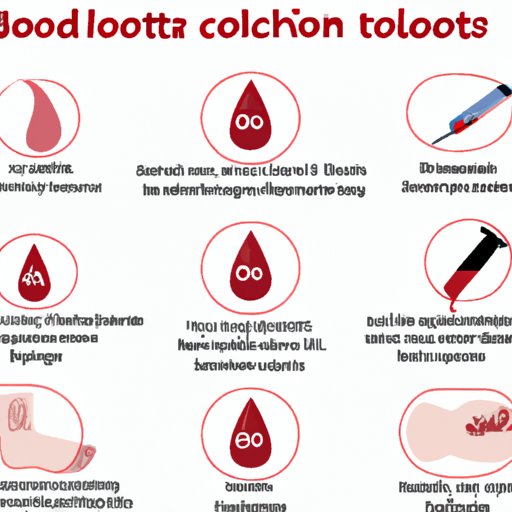
Introduction
Blood clots, also known as thrombi, are blockages that can occur in the blood vessels, preventing the normal flow of blood. These clotting incidents can be life-threatening, making it vitally important to detect them as early as possible. In this article, we will explore how to identify blood clots, what to do, how to prevent it and when to seek medical attention.
Symptoms, Prevention, and Treatment: Everything You Need to Know About Blood Clots
When blood clots form, a network of proteins and platelets work together to create a sturdy plug to stop bleeding. However, in some cases, the clotting process can occur unnecessarily or too aggressively, leading to blood clots that can block blood vessels. Common symptoms of blood clots include pain, warmth, and a red or blue discoloration in the affected area. If you experience these symptoms, seek medical attention immediately, especially if you also experience shortness of breath, chest pain, or blurred vision.
Preventative measures to reduce the risk of developing blood clots include staying active, maintaining a healthy weight, and avoiding prolonged periods of sitting or standing. Medical treatment options for blood clots include anticoagulants (blood thinners) or thrombolytic therapy (clot-dissolving medication).
Blood Clots: What You Need to Watch Out For
Certain risk factors increase the likelihood of developing blood clots, including obesity, smoking, hormonal changes (such as pregnancy or taking birth control pills), and having a family history of clotting disorders. Additionally, blood clots tend to occur more frequently in specific locations in the body, including the legs, lungs, and brain. Blood clots in the lungs, known as pulmonary embolisms, can be particularly dangerous and even fatal if not treated quickly.
The Silent Killer: Signs of Blood Clots You Shouldn’t Ignore
Blood clots can manifest in different ways, depending on the location of the blockage or the health of the person experiencing them. Some people may not experience any symptoms at all, making it important to monitor for possible risk factors and warning signs. Common signs to look out for include swelling and tenderness in the affected area, coughing up blood, and sudden or severe headaches.
If you experience any of these symptoms, especially with a history of clotting disorders, seek medical attention immediately. Do not ignore the signs of blood clots, as they can be incredibly dangerous.
How to Detect Blood Clots Early: Risk Factors and Warning Signs
Early detection of blood clots is crucial, and monitoring for potential risk factors can help in detecting it early. Risk factors that increase the likelihood of developing blood clots include smoking, obesity, a sedentary lifestyle, and age. Warning signs include unexplained pain, swelling, and warmth in the affected area, shortness of breath, and chest pain
Are You At Risk for Blood Clots? Understanding Clotting Disorders
Some people are at higher risk of blood clots, even without a history of clotting disorders. Clotting disorders are conditions in which the body produces too many blood clots or has difficulty dissolving clots that have already formed. Symptoms may include unexplained bruising, excessive bleeding, or clotting at unusual sites.
It’s important to understand the difference between normal and abnormal clotting processes and seek medical attention if you suspect a clotting disorder.
Conclusion
Blood clots can be a silent killer, and it’s worth taking preventative measures and being aware of warning signs to ensure you detect any potential blood clots as early as possible. Taking a proactive approach can help reduce the risk of developing blood clots, and seeking medical attention promptly can be life-saving.
If you experience any warning signs or have any concerns about your risk for developing blood clots, it’s crucial to speak with your healthcare provider immediately.




